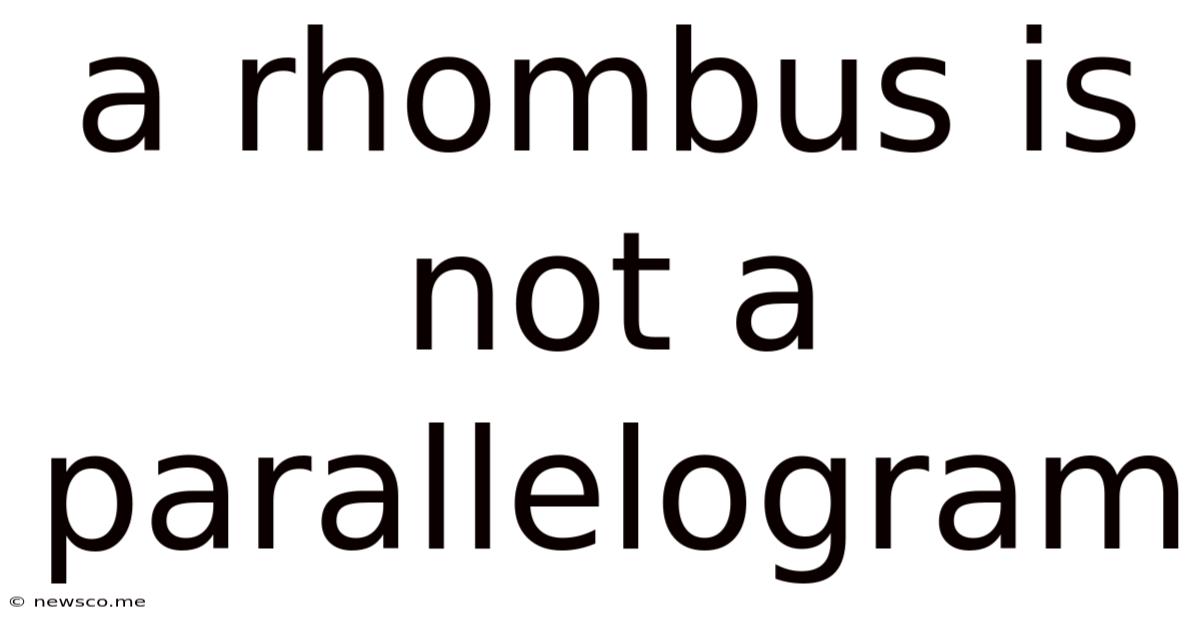A Rhombus Is Not A Parallelogram
News Co
Apr 17, 2025 · 4 min read

Table of Contents
A Rhombus is NOT a Parallelogram: Untangling Geometric Misconceptions
The statement "a rhombus is not a parallelogram" is, unequivocally, false. This common misconception arises from a misunderstanding of the definitions and relationships between different quadrilaterals. Understanding the hierarchy of quadrilaterals is crucial to clarifying this. Let's delve into the specifics, dissecting the properties of parallelograms and rhombuses to definitively prove their relationship.
Understanding Quadrilaterals: A Family Tree
Before we tackle the rhombus-parallelogram debate, let's establish the broader context. Quadrilaterals are four-sided polygons. Within this family, we find various specialized types, each with unique properties. Think of it as a family tree:
- Quadrilateral: The broadest category, encompassing all four-sided shapes.
- Trapezoid/Trapezium: A quadrilateral with at least one pair of parallel sides.
- Parallelogram: A quadrilateral with two pairs of parallel sides. This is a crucial defining characteristic.
- Rectangle: A parallelogram with four right angles.
- Rhombus: A parallelogram with four congruent (equal length) sides.
- Square: A parallelogram with four congruent sides and four right angles. It's both a rectangle and a rhombus.
This hierarchical structure is key. A rectangle is a parallelogram, a square is a rectangle (and thus a parallelogram), and a rhombus is a parallelogram. This is because each subsequent shape inherits all the properties of its predecessors.
Defining Parallelograms: The Key Properties
Parallelograms possess several defining properties:
- Opposite sides are parallel: This is the fundamental property.
- Opposite sides are congruent (equal in length): A direct consequence of parallel sides.
- Opposite angles are congruent: Another consequence of parallel sides.
- Consecutive angles are supplementary: Meaning their sum equals 180 degrees.
- Diagonals bisect each other: The diagonals intersect at their midpoints.
These properties are essential for proving that a rhombus is indeed a type of parallelogram.
Defining Rhombuses: Beyond Equal Sides
A rhombus is often described as a quadrilateral with four equal sides. While this is true, it's not the complete picture. The more precise definition is: a parallelogram with four congruent sides. This highlights the crucial relationship: a rhombus inherits all the properties of a parallelogram and adds the extra condition of equal sides.
Proving the Relationship: Rhombus as a Special Parallelogram
Let's systematically demonstrate why a rhombus is a parallelogram:
- Start with the definition: A rhombus is a parallelogram with four congruent sides.
- Parallelogram properties: By definition, a parallelogram has two pairs of parallel sides, opposite sides congruent, opposite angles congruent, consecutive angles supplementary, and diagonals that bisect each other.
- Rhombus inherits these properties: Because a rhombus is a parallelogram, it automatically possesses all the properties listed above.
- Additional property: The rhombus adds the extra property of having four congruent sides.
Therefore, a rhombus satisfies all the conditions of a parallelogram and then some. It is a special case of a parallelogram, a subset within the broader parallelogram category.
Common Mistakes and Misunderstandings
The misconception that a rhombus is not a parallelogram likely stems from focusing solely on the equal sides aspect of the rhombus, neglecting the parallel sides condition. Students might mistakenly believe that the equal sides definition is exclusive and sufficient, ignoring the inherent parallelogram properties.
Some common errors include:
- Confusing necessary and sufficient conditions: Equal sides are a necessary condition for a rhombus, but not a sufficient condition to define a parallelogram. Parallel sides are also necessary for a parallelogram.
- Ignoring the hierarchical structure: Failing to understand the hierarchical relationship within quadrilaterals leads to misclassifications.
- Oversimplification of definitions: Reducing the definition of a rhombus to just "four equal sides" omits the crucial aspect of it being a parallelogram.
Visualizing the Relationship: Diagrams and Examples
Visual aids are crucial for understanding geometric concepts. Consider the following:
- A square: A square is both a rectangle and a rhombus. It satisfies all the conditions for both shapes and is a perfect example of the hierarchical inclusion.
- A non-square rhombus: Draw a rhombus with angles that are not 90 degrees. It still possesses all the properties of a parallelogram: parallel sides, congruent opposite sides and angles, and diagonals that bisect each other.
These visual examples reinforce the idea that a rhombus is a specialized type of parallelogram.
Applications in Real-World Scenarios
Understanding the relationship between rhombuses and parallelograms is not just an academic exercise. These shapes appear in numerous real-world applications:
- Engineering: The structure of many bridges and buildings incorporates parallelogram and rhombus shapes for strength and stability.
- Art and Design: Rhombuses and parallelograms are frequently used in artistic designs and tessellations, showcasing the mathematical beauty of these shapes.
- Computer Graphics: The programming of computer graphics often relies on geometric principles, including the properties of parallelograms and rhombuses.
Conclusion: Settling the Debate
The evidence is clear: a rhombus is a parallelogram. The misconception arises from incomplete or inaccurate definitions and a lack of understanding of the hierarchical relationships among quadrilaterals. By emphasizing the defining properties of each shape and recognizing that a rhombus inherits all the characteristics of a parallelogram, we can dispel this common geometric misunderstanding. Understanding this relationship is not only essential for mastering geometry but also for appreciating the interconnectedness of mathematical concepts and their diverse applications in various fields. Remember the family tree, visualize the shapes, and you'll never confuse a rhombus and a parallelogram again.
Latest Posts
Related Post
Thank you for visiting our website which covers about A Rhombus Is Not A Parallelogram . We hope the information provided has been useful to you. Feel free to contact us if you have any questions or need further assistance. See you next time and don't miss to bookmark.